Israeli probe flies to the moon
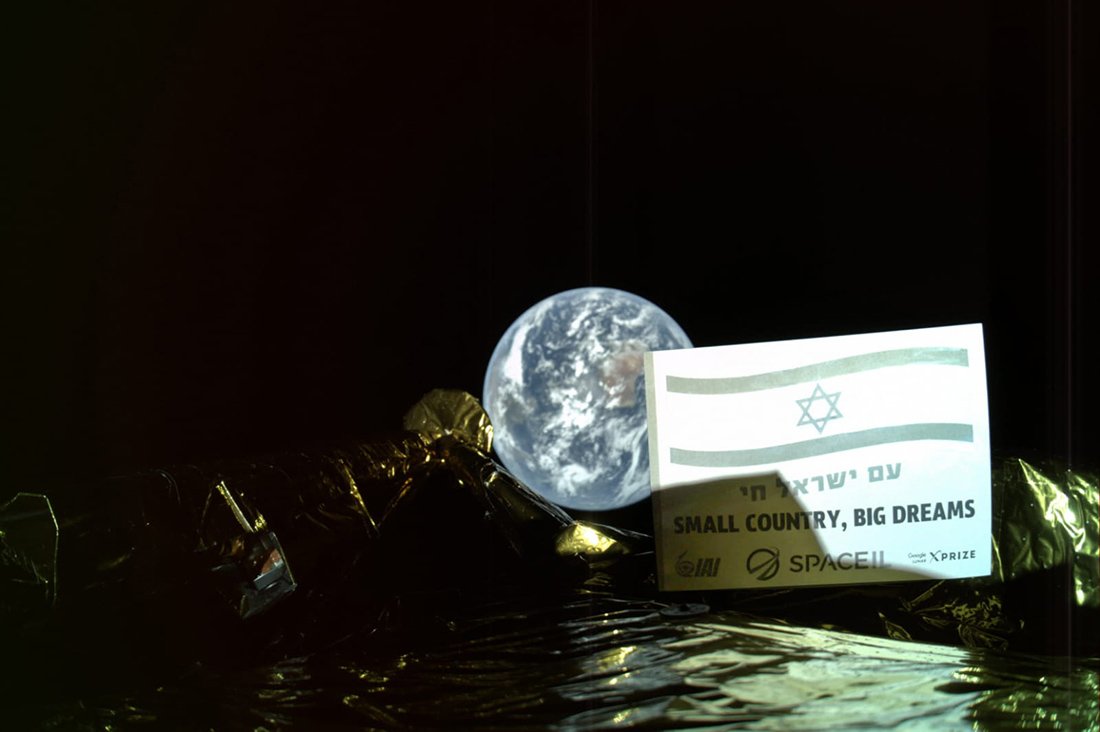
Beresheet automatic interplanetary station with a star of David on board launched to the moon on an American rocket. Israel is preparing to become the fourth state whose spacecraft will land on the Earth’s natural satellite. The station was designed and built mainly by private means, it will have many maneuvers, and the flight will take several weeks, but on the surface the work will last only two earth days.
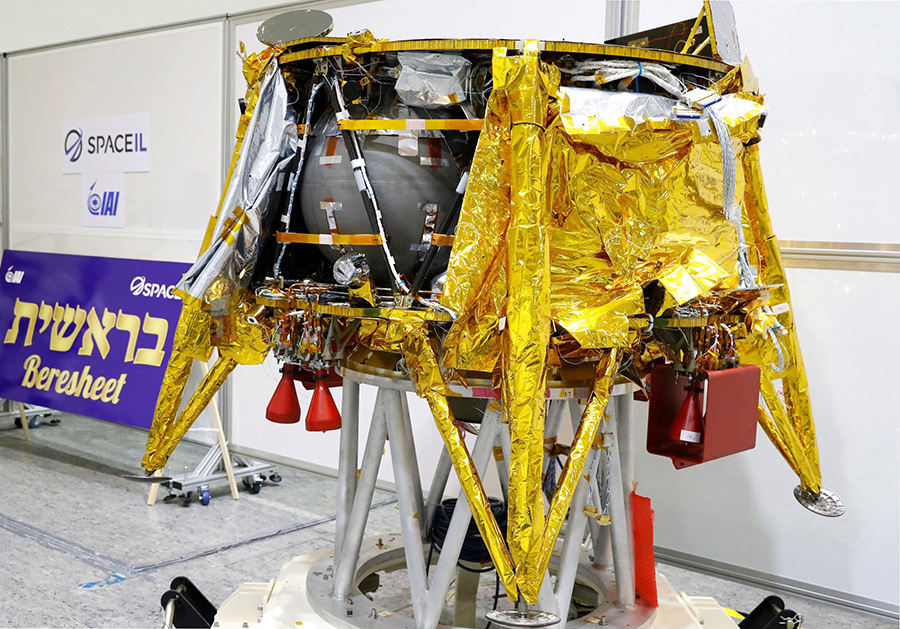
In 2007, the Google Lunar XPrize contest was launched under the terms of which up to $ 25 million could be obtained by a team that created a lunar spacecraft using private funds. The device was required to gently land on the moon, overcome on the surface of 500 meters and transmit to the Earth 500 megabytes of data. They promised to pay additional prizes for taking pictures of places and objects of previous landings, for the international composition of the team, range and duration of active existence.
In 2009, three young Israeli engineers decided to reach the moon and applied for participation in the competition. The team was called SpaceIL, and she took up the development of a lightweight and simple probe capable of fulfilling the conditions of the competition. Unlike most of its competitors, including the Russian "Selenohod" SpaceIL did not engage in a moon rover, i.e. lunar vehicle, and the movement of 500 meters was supposed to be done in one jump due to soft landing rocket engines.

Also, unlike most teams, Israeli engineers on the other hand approached the task. Basically, the teams approached the competition as an engineering task: they designed and assembled prototypes of lunar rovers and landing systems, trying to meet the stated budget. SpaceIL took shape as a public organization, engaged in the popularization of astronautics, and positioned its project as educational: went to schools and institutes. The team raised to the flag the national idea of Israel achieving the moon and the development of engineering in the country.
The road to the moon through school and the national idea turned out to be well chosen. SpaceIL found serious support in the person of South African-Israeli philanthropist Morris Kahn , who invested a total of $ 40 million in the project, then came support from billionaire Sheldon Adelson, who allocated $ 24 million and several other major sponsors. Seeing that the team was serious, the project was supported by the Israeli space agency and the IAI (Israel Aerospace Industries) state corporation, which is engaged in the development of space technology. The state funded the project first at $ 2 million, then another $ 7.5 million. In addition, crowdfunding campaigns were also carried out ($ 283 thousand were raised), and now everyone can support the project through their website.
IAI undertook the technical implementation of the project - the development and manufacture of the spacecraft and its preparation for launch. In total, the development, production and launch of the spacecraft required about $ 100 million, including an extensive educational and public relations campaign, primarily in Israel. Moreover, SpaceIL still owes $ 10 million for the spacecraft, but IAI is in no hurry to collect debt, realizing that the entire project is an advertisement for their products.
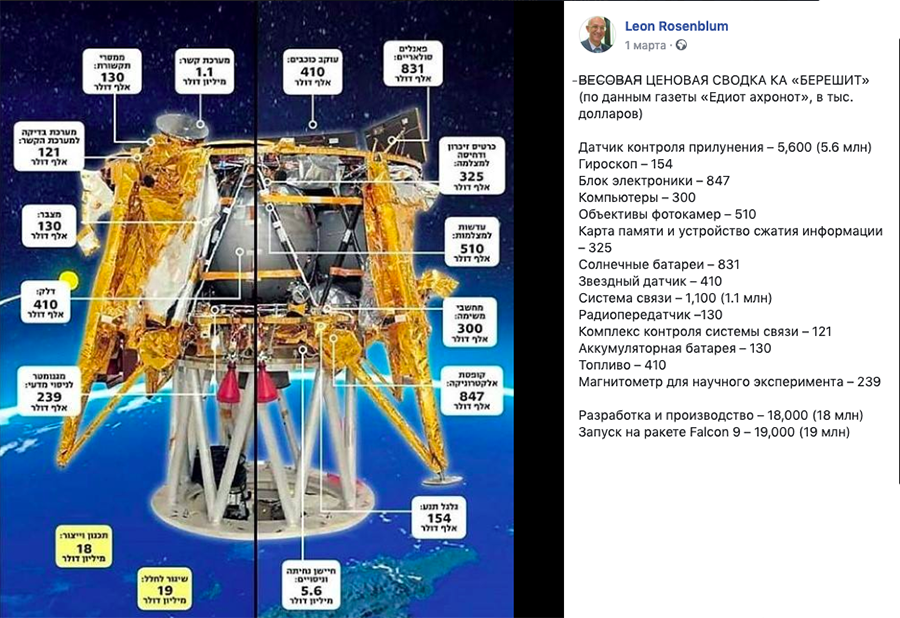
Infographic Ynet.co.il , translation by Leon Rosenblum .
The estimated shape of the probe has changed. They quickly abandoned the attempt to land the three-kilogram cubsat on the moon - the device became larger. A few years before the start, the team demonstrated a device that designers obviously worked on more than designers.
However, the finished probe, which was produced by the IAI at that time, nevertheless remotely resembles the declared “design layout”.

The name also changed. At first, the team proposed Hopper, the “bouncer,” then Sparrow, the “sparrow,” but two months before the launch, Beresheet - “In the Beginning” - according to the first words of the Scripture, was chosen during an open online vote.
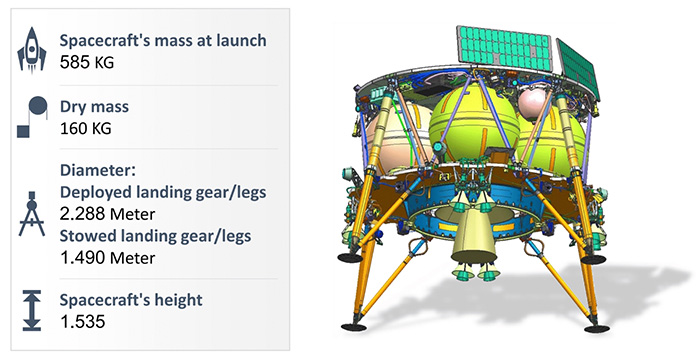
Beresheet is a small descent platform, the classic four-legged layout, weighing 585 kg in the filled state. Dry weight 150 kg. To start from Earth, Falcon 9 rockets were chosen, which, in passing, put the device into an extended near-earth orbit up to 60 thousand km high.

Further, several engine starts are provided to increase the orbit to an altitude of about 380 thousand km, where the braking maneuver will allow us to switch to a lunar orbit. Several inclusions are also supposed there already to lower the orbit with the final soft landing. The jump on the surface was abandoned, probably in order to save fuel mass.

The device is equipped with two types of engines: a two-component propulsion system, a hydrazine / mixed nitrogen oxide fuel pair. Eight auxiliary thrusters are single-component hydrazine. During the flight, they act as orientation and stabilization engines, supporting the necessary direction of turning on the main engine. During landing, they will also provide stabilization and help the marching engine damp speed.

The design of Beresheet is mainly based on proven technologies, but it was not without novelty. The brackets of the soft landing engines were developed by topological optimization and made by 3D printing with metal.

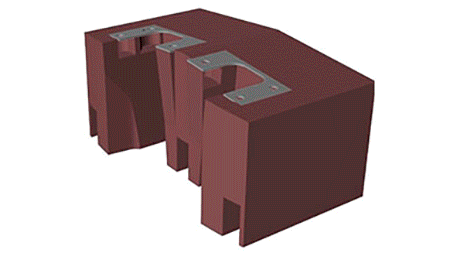
Unlike most government interplanetary spacecraft, Beresheet carries very little payload. In fact, his task is simply to sit on the moon. Of the scientific instruments on the apparatus, there is only a magnetometer, which will measure the strength of the residual magnetic field in the near-moon medium and the landing site. NASA also placed a corner reflector on the Israeli device, which will allow laser monitoring from near-moon orbit or from the Earth.
As a cultural payload, not a scientific one, a “time capsule” was placed on the Beresheet. This is a package of thin nickel plates on which information is printed by laser engraving. The SpaceIL team reported that it recorded texts of state documents, national cultural works, drawings prepared by mission enthusiasts, and information about project participants on plates.

Actually there is a lot more information. The idea of a “time capsule” belongs to the Arch Mission Foundation , whose goal is to preserve information about human civilization. Using NanoArchival Technologythey document the most important information about humanity. The package sent to the moon contains 25 plates with a thickness of 40 nanometers. The first four plates carry information recorded in analog format, i.e. just microscopic photographs, infographics, texts in various languages. A powerful microscope is enough to read them.

It provides basic information about the Earth and Earthlings, linguistic data about earthly languages, as well as information on decoding the underlying digital records.
It is in these plates that Israeli materials are contained. Next comes the 21 plate, which is already a DVD record with more tightly packed data on the inhabitants of the Earth and their achievements: Wikipedia, artworks, technical and scientific guides, etc. A total of about 200 gigabytes of information are encoded.

The process of choosing a landing site is curious . The visible side of the moon is chosen for the convenience of radio communications. To facilitate this task, landing is not supposed to be close to the edge of the visible disk of the moon. Beresheet is trying to stay farther from the equator, according to the requirements of ensuring thermal conditions. Under direct sunlight, there is a danger of overheating. The only scientific device - a magnetometer - requires landing in a region where the residual surface magnetization is strong enough.

Information in the Russian media slipped that Beresheet would try to remove the landing sites of Apollo 17 or Lunokhod-2, since the same Sea of Clarity where they had landed was chosen for landing. However, the planned landing site is hundreds of kilometers from the traces of previous expeditions, and the Israeli apparatus has only wide-angle landing cameras that will not allow it to see such small details at such a distance. So, what can you expect yellow headlines in Russian-language media like "The Israeli probe has not found traces of Americans on the moon."

Just a few months before the launch, SpaceIL signed a partnership agreement with NASA, under which the US space agency will help the team with the transfer of data to Earth. Using a network of 70-meter antennas NASA Deep Space Network, Israelis will be able to transmit more information to Earth. True, the volume is no longer so important, the Google Lunar XPrize contest has actually closed, and the team is no longer waiting for any prizes.
Landing of the Beresheet is expected in mid-April, possibly even on the 12th, if everything goes as planned. A stellar sensor malfunction has already been revealed and an unexpected restart of the computer occurred, which did not allow the engines to be turned on at the right time, and forced it to leave for a new circle. Since then, several more planned engine starts have passed and the flight program is developing successfully.
However, the project can already be called successful, because this is the only team in the competition that still reached the launch. In interplanetary space, it is the first Israeli spacecraft and one of the first privately funded.

When wondering why SpaceIL was able to do what three dozen teams from around the world could not or did not have time, several distinguishing features can be distinguished:
1. Lucky with the philanthropist. Morris Kahn (Morris Kahn) from an early stage to a critical situation when the finished device did not have enough money to launch, supported the project with its tens of millions and its authority, emphasizing faith in the team and technique.
2. Technical simplicity. As part of the competition, the team from the very beginning chose the simplest of the available landing and movement schemes. The creation of a full-fledged wheeled or walking lunar rover is an interesting and creative process that has attracted many developers, but it also requires a descent vehicle to land it, i.e. the choice of the lunar rover leads to the task of creating two spacecraft, rather than one.
3. Ideology. The team proclaimed a goal that is understandable and important in Israel - to reach new heights under the flag with the star of David, to develop young engineering personnel that will ensure the future technological development of the country.
4. Reliance on existing technology and production. Most of the participants in the contest tried to create spacecraft on their own, often “on their knees”. This allowed to save money, but generated a distrust in the quality of the created equipment on the part of potential investors or partners. SpaceIL solved the problem with money, but the transfer of all technical work to the outsourcing of the state corporation ensured the reliability of the device and high confidence in success.
I express my gratitude to Leon Rosenblum for help with finding information and timely coverage of the mission.
PS It turned out that there was already a post on Beresheet recently. Here is more information on the technical part.
